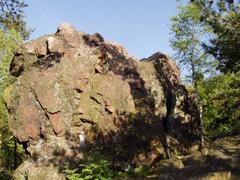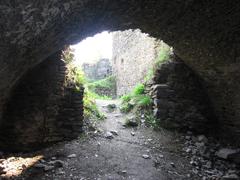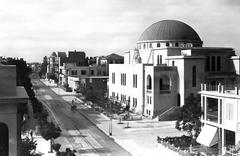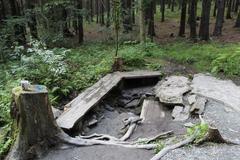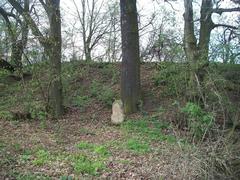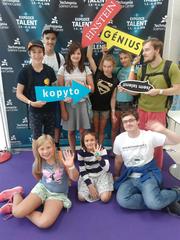
Visiting Petrovka: Hours, Tickets, and Tips
Date: 17/08/2024
Introduction
Welcome to Petrovka, an often-overlooked treasure in the heart of Plzeň, Czech Republic. This ecological and historical gem offers visitors a unique blend of natural beauty and rich cultural heritage. Nestled within the Plzeň Basin, Petrovka is a natural reserve that features wetlands, meadows, and peat bogs, making it an essential ecological zone for numerous protected and endangered species. The site is characterized by its diverse ecosystems, including wetlands, pine forests, and meadows, which collectively support a rich variety of flora and fauna. Notably, the area is home to peat layers that are up to five meters thick, highlighting its ancient ecological significance (source & source).
The historical backdrop of Petrovka and the broader region of Plzeň is equally compelling. The area has a rich history dating back to the medieval period, with the first recorded mention of Plzeň occurring in 976 AD. Over the centuries, the town evolved through various historical phases, including the Renaissance and Baroque periods, marked by significant architectural and cultural developments. The Industrial Revolution further transformed Plzeň into a major industrial hub, with establishments like the City Brewery and Skoda Works laying the foundation for its modern economic landscape (source).
In addition to its historical and ecological significance, Petrovka and Plzeň offer a range of attractions and activities for visitors. From the towering St. Bartholomew’s Cathedral and the iconic Pilsner Urquell Brewery to the fascinating Pilsen Historical Underground, the area is a treasure trove of cultural and historical landmarks. Whether you’re a history buff, nature enthusiast, or someone looking to experience authentic Czech culture, Petrovka and Plzeň have something special to offer (source).
Table of Contents
Historical Background
Early History and Formation
Petrovka, a natural reserve and small watercourse in the cadastral area of Plzeň, is known for its wetland and floodplain communities, with peat layers up to 5 meters thick in some places. This region is a perfect example of tectonic conditions leading to the formation of a dry pseudokarst valley, one of the oldest peat bogs in the Plzeň Basin. The wetland meadows here are home to protected and endangered plant and animal species, making it a vital ecological zone (source).
Medieval Period
The broader region of Plzeň, where Petrovka is located, has a rich medieval history. The first written record of Plzeň dates back to 976 AD. By 992 AD, Bishop St. Vojtech had founded a small monastery and a church, now known as the Church of St. George in Doubravka. The town of New Pilsen was officially founded in 1295 by King Wenceslas II, designed by the royal architect Jindrich. The town’s layout featured a rectangular grid of 15 streets and a central square, covering an area of 20 hectares (source).
Renaissance and Baroque Influence
The 16th century saw significant changes in Plzeň, especially after several fires damaged the town’s inner center. Italian architects and builders, including the renowned Giovanni de Statia, played a crucial role in reshaping the city’s character. The Holy Roman Emperor and Czech King Rudolf II resided in Plzeň twice between 1599 and 1600 during the Estates revolt, further enhancing the city’s prominence. Many Baroque-style buildings from the late 17th century were designed by Jakub Auguston, with sculptures by Kristian Widman (source).
Industrial Revolution and Modern Era
The 19th century marked a period of tremendous growth for Plzeň. The City Brewery was founded in 1842, and the Skoda Works in 1859, both of which played pivotal roles in the city’s development. By the early 20th century, Plzeň had become a significant industrial hub. The city experienced a two-month occupation by Prussian soldiers in 1866 and continued to grow, reaching a population of 167,000 by the early 20th century (source).
World War II and Post-War Period
During World War II, Plzeň was a crucial site for the German war effort, producing weapons and other military supplies. The city was heavily bombed, resulting in significant casualties and damage. In 1945, Plzeň was liberated by the American army, marking the end of Nazi occupation. The post-war period saw the establishment of several educational institutions, including the Medical Department of Charles University in 1945 and the Pedagogical Faculty in 1948 (source).
Communist Era and Modern Developments
The communist era brought significant changes to Plzeň. In 1953, citizens demonstrated against monetary reform and the communist regime, but the uprising was suppressed. The construction of blocks of flats began in the late 1950s, transforming the city’s landscape. By 1972, the population had reached 150,000. The administrative body of modern-day Plzeň was established in 1976, and the city continued to grow and develop through the late 20th century (source).
Visitor Information
Ecological Significance of Petrovka
Petrovka’s ecological importance cannot be overstated. The reserve protects natural wetland and floodplain communities, with a rich biodiversity that includes several protected and endangered species. The peat layers, some up to 5 meters thick, are a testament to the area’s ancient ecological history. The reserve is managed by the Environmental Department of the Plzeň City Council, ensuring its preservation for future generations (source).
Cultural and Historical Landmarks
Plzeň is home to several cultural and historical landmarks that reflect its rich history. The St. Bartholomew’s Cathedral, with the highest church tower in the Czech Republic, is a prominent feature of the city. The Pilsner Urquell Brewery, founded in 1842, is another significant landmark, offering tours that showcase the history and process of beer-making. The Great Synagogue, the second-largest in Europe, is a testament to the city’s diverse cultural heritage (source).
Visitor Tips
For those planning to visit Petrovka and Plzeň, here are some essential tips:
- Best Time to Visit: The summer months of June, July, and August offer warm and pleasant weather, ideal for exploring the natural beauty of Petrovka. The shoulder seasons of spring (April and May) and autumn (September and October) are also good times to visit, with milder weather and fewer crowds (source).
- Transportation: Plzeň has an efficient public transportation system, including trams and buses. Consider purchasing a transportation pass if you plan to use public transit frequently. Walking is also a great way to explore the city center (source).
- Accommodation: Plzeň offers a range of accommodation options to suit different budgets and preferences. Staying in the city center puts you within walking distance of major attractions, restaurants, shops, and nightlife (source).
- Local Cuisine: Don’t miss the opportunity to sample traditional Czech dishes, such as goulash, roast pork with dumplings, and trdelník (a sweet pastry). Pair your meals with Pilsner beer for an authentic experience (source).
FAQ
What are the visiting hours for Petrovka?
Petrovka is open year-round. However, the best time to visit for optimal weather conditions is during the summer months of June to August.
Are there any ticket prices for visiting Petrovka?
There is no entrance fee to visit Petrovka. It is a public natural reserve managed by the Environmental Department of the Plzeň City Council.
Are guided tours available?
Yes, guided tours can be arranged through the Plzeň City Council’s Environmental Department. Check their official website for more details and booking options (source).
What are some must-see nearby attractions?
In addition to Petrovka, visitors should not miss the St. Bartholomew’s Cathedral, the Pilsner Urquell Brewery, and the Great Synagogue in Plzeň.
Conclusion
Petrovka and Plzeň offer a rich tapestry of history, culture, and natural beauty. Whether you are a history buff, nature lover, or simply looking for a unique travel experience, this region has something for everyone. Plan your visit today and discover the wonders of Petrovka and Plzeň!
For more information and updates, follow us on social media and check out our other related articles. We encourage you to download the Audiala app for more travel tips and insights. Safe travels!


